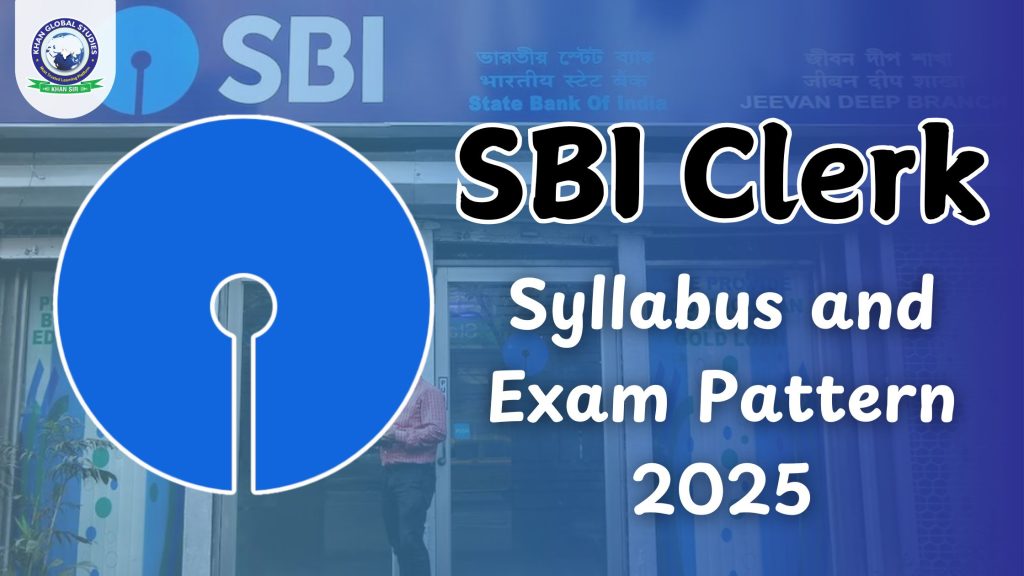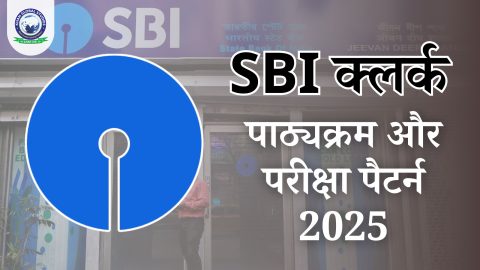Aspirants of the SBI Clerk exam 2025 should familiarize themselves with the detailed SBI Clerk syllabus 2025 to optimize their preparation strategy and ensure success. The exam, which consists of both prelims and mains, will be conducted soon after the application process ends. Therefore, it is important to have a deep understanding of the syllabus and exam pattern to pass this competitive exam.
The SBI Clerk exam consists of two stages: Preliminary Exam and Mains Exam. While the topics covered in both stages are quite similar, the main exam introduces additional topics and tests candidates at a higher level of difficulty. Below, we will break down the syllabus of both stages, including the topics required for each section and the exam structure.
SBI Clerk Syllabus and Exam Pattern Overview
| Name of Exam | State Bank of India (SBI) Clerk Exam |
| Mode of Exam | Online |
| Exam Type | Objective (MCQs) |
| Exam Medium | Bilingual Except for the English Language |
| No. of Questions | Prelims Exam: 100 Mains Exam: 190 |
| Maximum Marks | Prelims Exam: 100 Mains Exam: 200 |
| Marking Scheme | +1 for each correct answer -0.25 for each wrong answer |
| Time Duration | Prelims Exam: 1 Hour Mains Exam: 2 Hours 40 Mins |
| Job location | PAN India |
| Official Website | https://sbi.co.in/ |
SBI Clerk Prelims Syllabus 2025
The preliminary exam is the first hurdle for banking aspirants testing the foundational knowledge and skills required for a role in the banking sector. The SBI Clerk preliminary exam syllabus 2025 consists of three major sections: English Language, Numerical Ability, and Reasoning Ability, and carries a total of 100 marks.
Main Topics for the SBI Clerk Prelims Exam
1. Reasoning Ability
The reasoning section assesses the logical thinking and problem-solving abilities of the candidate. The main topics covered here are:
- Blood Relation
- Direction and Distance
- Alphanumeric Series
- Syllogism
- Coding-Decoding
- Circular/Triangular/Square/Rectangular/ Seating arrangement
- Order & Ranking
- Inequality
- Box based Puzzle
- Floor based Puzzle
- Linear row/Double row arrangement
- Day/Month/Year/Age-based Puzzle
- Comparison/Categorised/Uncertain Puzzle
- Miscellaneous
2. Numerical Ability
Numerical Ability tests the candidate’s proficiency in mathematical calculations. The primary topics include:
- Simplification
- Approximation
- Missing Series
- Quadratic Equation
- Data Interpretation (Bar, Line, Pie, Tabular)
- Data Sufficiency
- Wrong Series
- Time & Work, Pipes & Cisterns
- Problems on Ages
- Average, Ratio, Percentage, Profit & Loss
- Simple Interest & Compound Interest
- Speed, Distance & Time
- Permutation & Combination
- Boat & Stream
- Mensuration
- Probability
- Partnership
- Mixture & Allegation
3. English Language
This section assesses the candidate’s understanding of basic English grammar and comprehension. The key areas of focus include:
- Reading Comprehension
- Phrase Replacement
- Fillers
- Odd Sentence
- Para Jumbled
- Cloze Test
- Inference, Sentence Completion
- Connectors
- Paragraph Conclusion
- Phrasal Verb-Related Questions
- Misspelt
- Error Detection
- Sentence-based Error
- Word Rearrangement
- Sentence Improvement
- Error Correction
- Word Swap
- Idioms & Phrases
- Column-based Sentences
SBI Clerk Mains Syllabus 2025
Once candidates clear the prelims, they will face the SBI Clerk Mains exam, which expands the topics covered in the prelims and introduces additional sections. The Mains exam includes the following subjects: General English, Quantitative Aptitude, Reasoning Ability and Computer Awareness, and General/Financial Awareness.
Key Subjects for SBI Clerk Mains:
1. General English
This section is similar to the prelims but with more emphasis on language proficiency and comprehension. The main topics include:
- Reading Comprehension
- New Pattern Cloze Test
- Phrase Replacement
- Odd Sentence out cum Para Jumbles
- Sentence Completion
- Paragraph Conclusion
- Phrasal Verb-related Questions
- Connectors
- Column based
- Word rearrangement
- Paragraph completion
- New pattern para jumbles
- Multiple error corrections
2. Quantitative Aptitude
This section extends the numerical aptitude section of the preliminary exam, containing more complex questions. The important topics are:
- Simplification and Approximation
- Basic Calculation
- Inequalities (Quadratic Equations, Quantity 1, Quantity 2)
- Time & Work
- Speed Time & Distance
- Simple Interest & Compound Interest
- Data Interpretation (Bar Graph, Line Chart, Tabular, Caselet, Radar/Web, Pie Chart)
- Number Series
- Arithmetic Problems
- Volumes
- Problems on L.C.M and H.C.F
- Quadratic Equations
- Probability
- Profit and Loss
3. Reasoning Ability
The reasoning portion covers the same topics as the preliminary exam but at a more advanced level. The main reasoning topics are:
- Puzzles
- Seating Arrangements
- Direction Sense
- Blood Relation
- Syllogism
- Order and Ranking
- Coding-Decoding
- Machine Input-Output
- Inequalities
- Alpha-Numeric-Symbol Series
- Data Sufficiency
- Logical Reasoning, Statement, and Assumption
- Passage Inference
- Conclusion, Argument
- Resultant Series
4. General Awareness
- National Current Affairs
- International Current Affairs
- State Current Affairs
- Sports News
- Central Government Schemes
- Agreements/MoU
- Books & Authors
- Summits & Conferences
- Defense News
- Science & Technology News
- Banking & Insurance News
- Static GK
- Ranks/Reports/Indexes
- Business & Economy Related News
- Important Days-Direct, Theme, Related Facts/News
- Obituaries
- Important Appointments-National, International, Brand Ambassador
- Important Awards & Honors
- Union Budget
- Current Static
- Apps & Portals
- Static Banking
- Committees/Councils
- RBI In News
- International Loans
- Abbreviation
5. Computer Awareness
This section focuses on testing the candidate’s knowledge of computer concepts related to banking. The main topics include:
- Fundamentals of Computer
- Future of Computers
- Security Tools
- Networking Software & Hardware
- History of Computers
- Basic Knowledge of the Internet
- Computer Languages
- Computer Shortcut Keys
- Database
- Input and Output Devices
- MS Office
SBI Clerk Exam Pattern 2025
The SBI Clerk Exam Pattern for both Prelims and Mains requires candidates to understand the structure of the exam. Prelims acts as a screening test, while Mains determines the final selection.
| Exam Level | Subjects | No. of Questions | Maximum Marks | Time Duration |
| Prelims Exam | English Language | 30 | 30 | 20 Minutes |
| Quantitative Aptitude | 35 | 35 | 20 Minutes | |
| Reasoning Ability | 35 | 35 | 20 Minutes | |
| Total | 100 | 100 | 60 Minutes | |
| Mains Exam | English Language | 40 | 40 | 35 Minutes |
| Quantitative Aptitude | 50 | 50 | 45 Minutes | |
| Reasoning Ability | 50 | 60 | 45 Minutes | |
| General Awareness | 50 | 50 | 35 Minutes | |
| Total | 190 | 200 | 2 Hours 40 Min | |
Preparation Strategy for SBI Clerk 2025
A well-structured study plan is crucial to crack the SBI Clerk exam 2025. Candidates should focus on the following strategies to maximize their chances of success:
- Understand the syllabus: Go through the detailed syllabus and exam pattern to identify the key topics.
- Take regular mock tests: Practice with mock tests to familiarize yourself with the exam format and improve time management.
- Stay updated: For the general/financial awareness section, stay updated with the latest current affairs and financial news.
- Time management: Prioritize time for different topics based on individual strengths and weaknesses.
- Focus on weak areas: Identify weak areas in your preparation and devote extra time to improve them.
By understanding the syllabus and exam pattern thoroughly and preparing strategically, candidates can boost their performance in the SBI Clerk 2025 exam.




